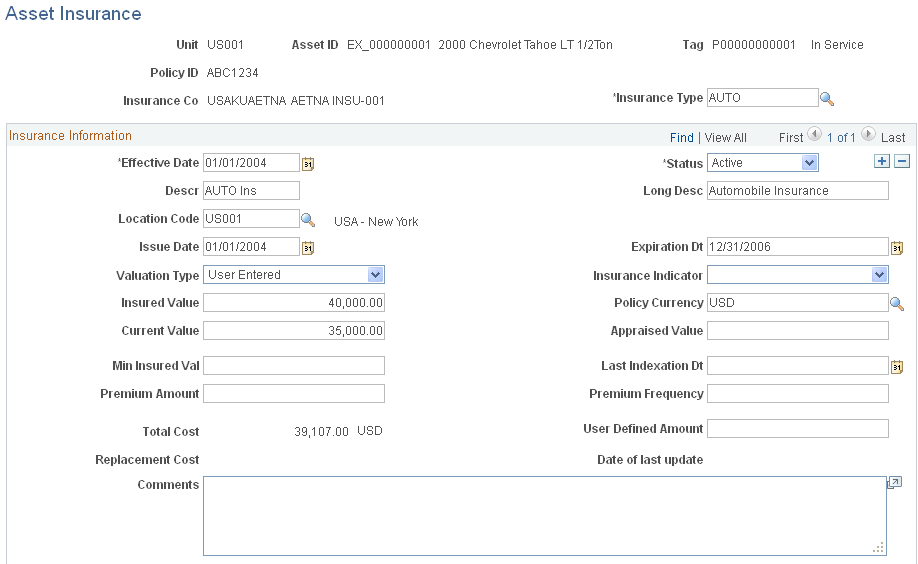Entering Asset Insurance Information
This topic lists prerequisites and discusses how to enter Asset Insurance information.
Use the Asset Insurance (ASSET_INSURANCE) component to set up asset insurance.
The Asset Insurance page captures all of the information necessary to track the insurance coverage for an asset. The Asset Insurance by Company query is provided to enable viewing of the insurance by business unit and vendor ID.
Note: (JPN) This feature satisfies the Japanese requirement to link an insurance policy ID to an asset ID.
|
Page Name |
Definition Name |
Usage |
|---|---|---|
|
ASSET_INSURANCE |
Track insurance information by asset ID. |
The asset insurance pages use data stored in the Vendor table and the Insurance Type table. Before you set up asset insurance, you must first define these tables and establish an asset ID.
To use the Asset Insurance page, you must first:
Establish insurance types.
Set up asset insurance vendors.
Use the Asset Insurance page (ASSET_INSURANCE) to track insurance information by asset ID.
Navigation:
This example illustrates the fields and controls on the Asset Insurance page. You can find definitions for the fields and controls later on this page.

Field or Control |
Description |
|---|---|
Unit |
Displays the business unit selected from the search criteria. |
Asset ID |
Displays the asset ID selected from the search criteria and with which this insurance information is associated. |
Tag |
Displays the asset tag number selected from the search criteria. |
Policy ID |
Displays the insurance policy ID if insurance information has previously been established or displays the ID entered when adding a new value. |
Insurance Co (insurance company) |
Displays the name of the insurance company for this coverage. The company must already be defined in the vendor file. |
Insurance Type |
Display or change the insurance type to correspond with this policy coverage. The available insurance types are defined during the setup process. |
Insurance Information
Field or Control |
Description |
|---|---|
Effective Date |
Indicates when the insurance coverage takes effect. If you want a history of changes, add new rows to the table and use effective dating to update insurance coverage, rather than making changes to the initial row. |
Status |
Refers to the status of the Effective Date row. |
Descr (description) |
Enter a description of the asset. |
Long Descr (long description) |
Enter a description of the asset. |
Issue Date |
Enter the insurance coverage issue date. |
Expiration Dt (expiration date) |
Enter the insurance coverage expiration date. |
Valuation Type |
Designate the insurance valuation calculation type used for this coverage. No processing takes effect as a result of this entry, but this entry identifies the appropriate calculating method in effect. The available insurance valuation types are:
|
Insurance Indicator |
Designate the type of asset and risk associated with the asset:On Loan or High Value. Use this indicator to identify assets with any special insurance characteristics for reporting purposes. |
Insured Value |
Enter the amount of the insured asset value. |
Policy Currency |
Select the policy currency type. The value of this field is defaulted from the base currency of the business unit default book. |
Current Value |
Enter the current value of the asset. |
Appraised Value |
Enter the appraised value of the asset. |
Min Insured Val (minimum insured value) |
Enter the minimum amount of insurance for the asset. |
Last Indexation Dt (last indexation date) |
Enter the last date on which an indexation for the asset took place. |
Premium Amount |
Enter the amount of the premium in full or periodically. |
Premium Frequency |
Enter the type of premium schedule such as annual, quarter, month and so on. |
Total Cost |
Displays the total cost, which is derived from the COST table and reported in the base currency of the default book. |
User Defined Amount |
Corresponds to User Entered value. |
Replacement Cost |
Displays the replacement cost, which is derived from the replacement cost calculated for the asset and stored on the Basic Asset page. |
Date of last update |
Displays the date of the last update to the replacement cost. |
Comments |
Enter any comments. This is a free-text field. |